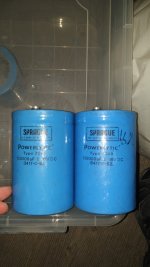Before using the capacitor, it is necessary to measure its capacity and internal resistance. Formatting restores the oxide layer and does not affect the electrolyte.Don't waste you're time trying to reform capacitors that have already expired.
Bueno.. yo vivo en California, que no se si es primer or tercer mundo... pero aun asi venden bombillas incandescentes para la nevera.Vivo en el primer mundo, todo LEDs, hay que joderse....
Amazon:
https://www.amazon.com/Watt-Medium-...9Y2xpY2tSZWRpcmVjdCZkb05vdExvZ0NsaWNrPXRydWU=
"This item cannot be shipped to your selected delivery location. Please choose a different delivery location."
Gotta say I'm getting pretty tired of this...
Maybe when I retire I will open up a proxy firm in Las Vegas where people can ship stuff that their domicile prevents them from getting.
I figure Californians will very soon keep me very active... Catalans too.
Gotta say I'm getting pretty tired of this...
Maybe when I retire I will open up a proxy firm in Las Vegas where people can ship stuff that their domicile prevents them from getting.
I figure Californians will very soon keep me very active... Catalans too.
Hi. I found a pair of 1984 model Sprague capacitors in my storehouse. They show about 0.05-0.08ohms esr and 99k-101k capacity.It seems good but what about performance? I want to use them for an amplifier. Can I drill a little hole on top plastic cover, fill some boric acid and maybe it improve performance ? I watched this video .

Attachments
Then maybe drill aluminium bottom and close it with argon welding lol. I just love experiments.I thought it can be better than being dry. Do you think it is dangerous?
Actually, yes. And it won't work. Nothing against experiments - that's how best to learn after all - but I would find something different to try.
And, for what it's worth, those capacitors are probably perfectly fine. The ESR and value are great - the only issue would be with leakage and those Sprague 736Ds won't be used anywhere that would matter. They are low frequency bulk filters and, used as such, would probably last another 20 or 30 years.
Hal
And, for what it's worth, those capacitors are probably perfectly fine. The ESR and value are great - the only issue would be with leakage and those Sprague 736Ds won't be used anywhere that would matter. They are low frequency bulk filters and, used as such, would probably last another 20 or 30 years.
Hal
If you need to discharge the caps, do that with a resistor; do not directly short the charged caps' terminals together; they hate when you do that to them.1K 10W is enough?
First is needed to discharge the caps, if yes I think using a resistor what wich value & power?
Actually, yes. And it won't work. Nothing against experiments - that's how best to learn after all - but I would find something different to try.
And, for what it's worth, those capacitors are probably perfectly fine. The ESR and value are great - the only issue would be with leakage and those Sprague 736Ds won't be used anywhere that would matter. They are low frequency bulk filters and, used as such, would probably last another 20 or 30 years.
Hal
Thanks for the answer. When i shake them one of them make sound (i think wrapped roll hits somewhere ) Is it because of being dry?
If it's doing that than just ignore everything that I just said. You are correct, it has dried out - I'm just very surprised that the capacitance value hasn't changed as that would be expected. Those would have been used as filters for probably a 5V rail which would have had high ripple currents - which would explain them drying out. Still, very unusual for the value and ESR not to have gone out of spec, though.
No, it is not because it is dry. It may be some loose debris from manufacturing, rattling in the void between the seal and the bulk of the armature. As you can guess by the abnormally big size compared to the capacitance value, those Sprague capacitors aren't built like today mainstream electrolytic capacitors. They were very expensive long-life parts. I have some of them built in the '60 that still works perfectly fine, like yours. They don't like high temperatures, this is another major limitation beside the size and price compared to modern high quality capacitors. They are vintage parts afterall, I use them for restorations only.
Last edited:
Hi.What are these sprague 36D apacitors for? As i know they are very expensive but they have only 1000Hour @85C !
What is special about them?
https://www.mouser.com/datasheet/2/427/36ddedx-1764091.pdf
What is special about them?
https://www.mouser.com/datasheet/2/427/36ddedx-1764091.pdf
https://www.xppower.com/resources/blog/electrolytic-capacitor-lifetime-in-power-supplies
Run them at 45C and the lifetime goes to 16,000 hours, about two years. Not great but not horrible.
And that's why all the gear I design has fans.
Manufacturers provide calculations to determine lifetime in application. These are based on the Arrhenius equation for temperature dependence of reaction rates. This determines that the reaction rate doubles for every 10°C rise in temperature. That means that the lifetime doubles for each 10°C reduction in temperature, so a capacitor rated at 5,000 hours at 105°C would have a service life of 10,000 hours at 95°C and 20,000 hours at 85°C.
Run them at 45C and the lifetime goes to 16,000 hours, about two years. Not great but not horrible.
And that's why all the gear I design has fans.
- Home
- Design & Build
- Parts
- Reforming electrolytic capacitors
